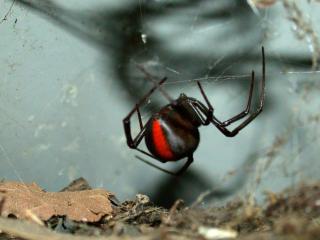Spiders are not insects but are in the class Arachnida and unlike insects they do not spread disease or plunder our food supplies. Spiders have only two body parts, the cephalothorax and the abdomen, and eight legs instead of six. All spiders spin silk, but not all build webs for the purpose of catching prey. Spiders such as the common wolf spider run down their prey and a trapdoor spider lays in wait in its burrow awaiting prey to pass by.
In Western Australia, the only spider proven to be lethal is the red-back spider. There has been an effective antivenene for this spider since 1956 and there have been no deaths from a red-back spider bite in Australia since 1955. We also have many species of the large trapdoor spiders and, although venomous, none of these are considered life threatening. We do not have the deadly funnel-web spider in this state.
Red-back spiders
Red-back spiders, Lactrodectus hasselti, are common and found throughout Australia. They are seen mostly in disturbed areas and seem to like living near humans. They nest in dry, sheltered areas where they build messy tangled webs with sticky tracer leads going to the ground that “crackle” if you run a stick through them.
The female is easily identified with her long delicate front legs and a red or orange stripe on her pea-shaped abdomen. She also has a red or orange hourglass shape on her underside. Only the female is considered dangerous but is generally a timid spider, biting only in defence or when disturbed. The male is very small, and his fangs are unable to penetrate human skin. Very often the male will be taken by the female as a meal during mating. Our red-back is the same spider as the black widow of north America.
Although red-back spider bites are usually immediately painful, the venom (which contains neurotoxins) works very slowly. Bites can result in headache, nausea, vomiting, abdominal pain, fever, hypertension and, in severe cases, paralysis.
Untreated, the symptoms worsen over a 24-hour period and may take weeks or months to heal. Red-back spider bites are the commonest poisonous bites requiring treatment in Australia, particularly over the summer months.

